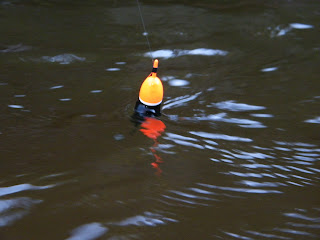A properly rigged and weighted float can deliver your offering at the precise speed of the current, allowing you to achieve a perfect drag free drift.
I like to
use floats from Raven Tackle that are specifically designed with steelhead
fishing in mind. They attach with surgical tubing and don’t fray your line
when you’re making adjustments to depth. They are also rated by a number that
lets you know how much split shot they can hold.
The first
order of business is getting down to the bottom where the fish are. You want to
space your split shot in such a way that the largest weight is on top to punch
through the heavy surface current, and the smallest amount is near your
offering. This is known as a shirt button split shot pattern. This allows your
offering to float downstream ahead of the float at the same speed as the
current. I start out by placing 4 BB split shot under the float and then taper
down. I pinch these split shot on by hand to not damage the line when making
adjustments to depth.
Presentation selection can vary. It can include such things as yarn tied to mimic a fish egg, stone and hex fly imitations, pink plastic worms, night crawlers, butter worms, wax worms and spawn. I've also had success with a local fly pattern known as a Lake Superior X-Leg. These are tied by a local company called Jeff's Jigs and are available online.
Start out
shallow and slide everything up after a few drifts. This avoids drudging bottom
and the possibility of spooking fish. The thing
about sensitive floats is they will let you know where you are
in the water column. If the float points downstream you are drudging bottom. If
the float points upstream you are either set too shallow or you need more
weight to match the current. What you want to see is the float straight up and
down and submerged to the point that only the top is visible.
This lets you know that everything is set up properly and you’re on your way to
a feisty steelhead.
Hydrology
tells us that the current in a river is actually faster on the surface than on
the bottom. It doesn't take long for the steelhead to notice when something
floating by them is awry. To slow the float down, we use a technique called
"trotting" or pulling back on the float slightly during your drift.
This allows you to slow the float to the same speed as the current on the
bottom.
Presentation selection can vary. It can include such things as yarn tied to mimic a fish egg, stone and hex fly imitations, pink plastic worms, night crawlers, butter worms, wax worms and spawn. I've also had success with a local fly pattern known as a Lake Superior X-Leg. These are tied by a local company called Jeff's Jigs and are available online.
Get out
and chase some of the hardest fighting, most beautiful fish that Minnesota has to offer. Please remember to handle these wild fish
with care.
Garett
Svir
Photography
by Kim Svir






No comments:
Post a Comment
Note: Only a member of this blog may post a comment.